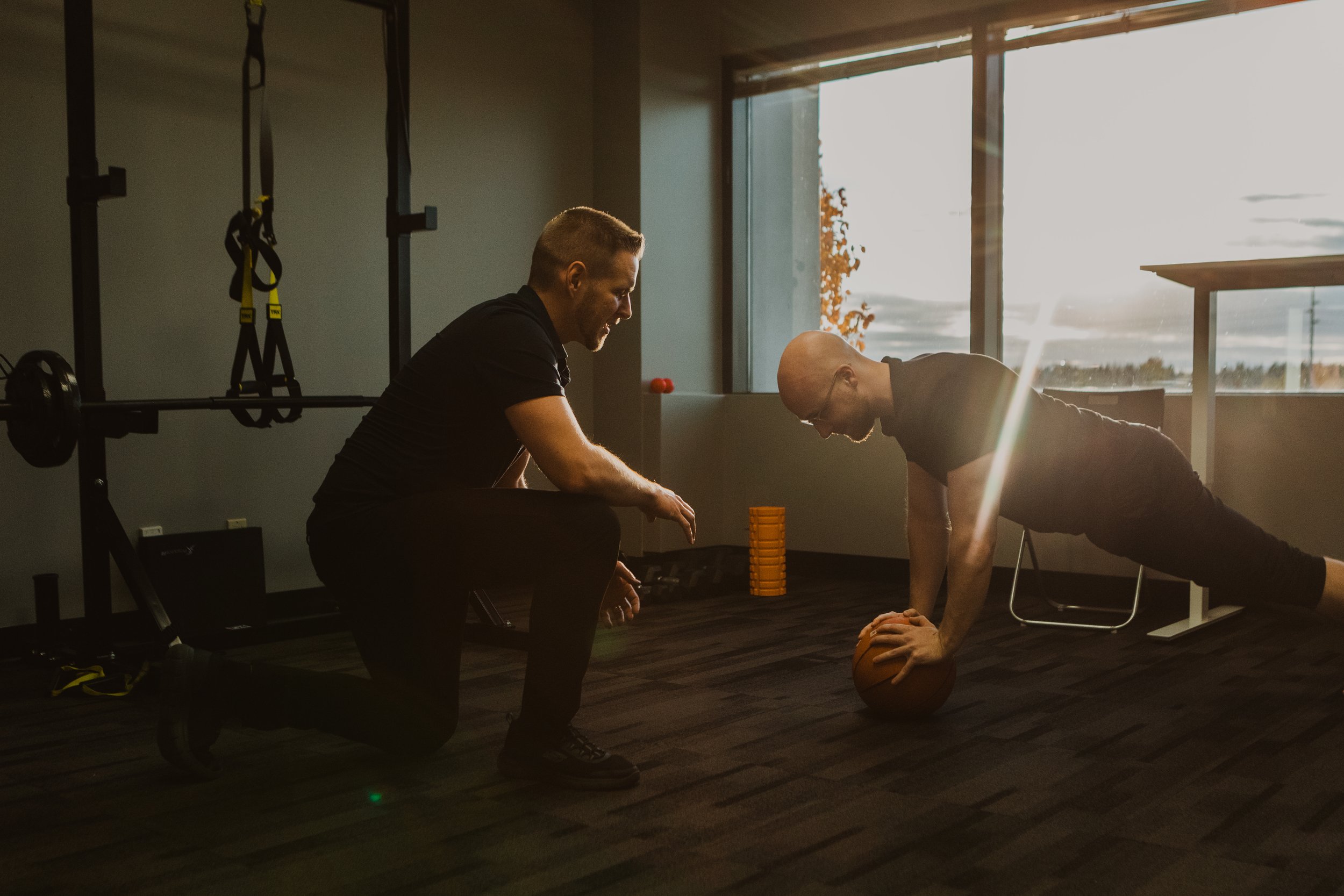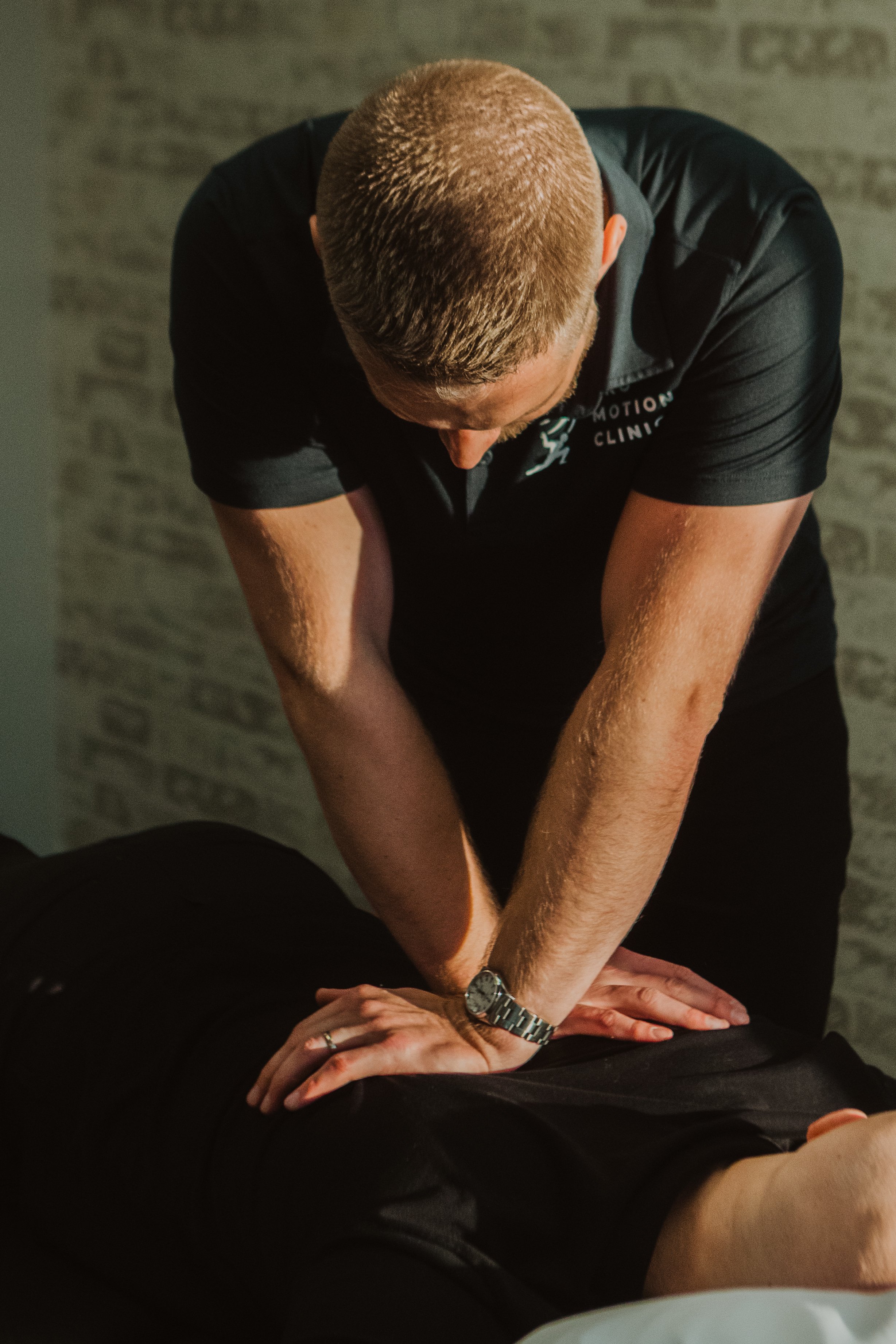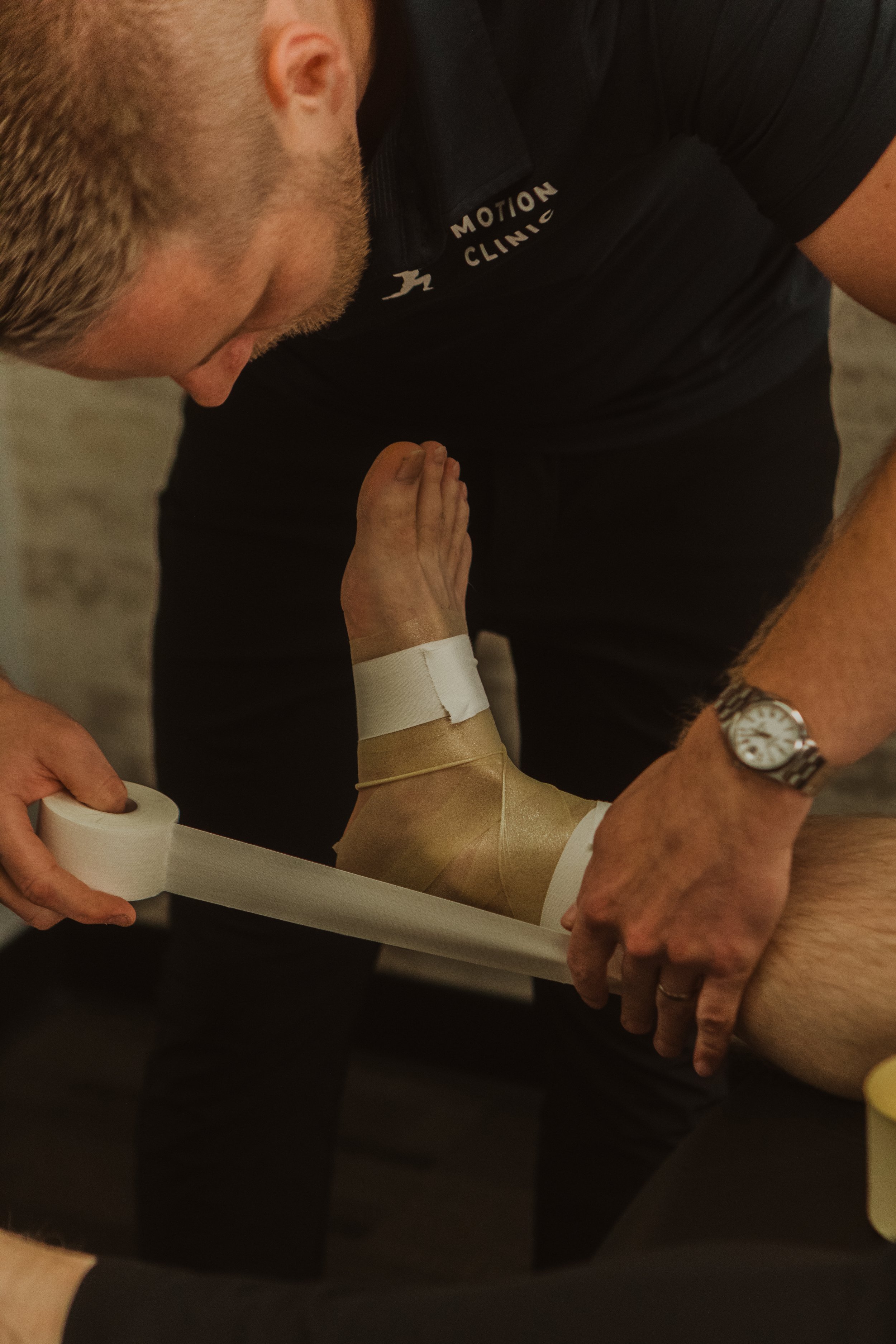Physiotherapy
What is Physiotherapy?
Physiotherapy is a multifaceted treatment approach to many neuromusculoskeletal ailments. Physiotherapy is also utilized by athletes of all types to help improve their physical performance during and between seasons. Physiotherapists can be found in clinics, hospitals, or even on the sidelines of sporting events. Each registered physiotherapist will typically have a bachelors and masters degree education in topics such as anatomy, physiology, biology, chemistry, physics, microbiology, and psychology.
Physiotherapy helps:
Relieve pain
Improve strength
Improve mobility and balance.
What should I expect on my first physiotherapy appointment at Pro Motion Calgary?
During your first visit, the physiotherapist will first conduct a subjective examination where they will listen to what brings you into the clinic and ask questions that pertain to your individual experience of your ailment. The next step is always a thorough physical assessment including specific tests to examine joint range of motion, muscle strength, nerve tension, functional movements, and orthopaedic special tests. From this point an assessment is made and your physiotherapist will work with you to develop a treatment plan that will enable you to achieve your physiotherapy goals, and when to return.
Treatment may include but is not limited to:
Manual therapy: joint mobilizations, soft tissue massage, neural glides
Education: post-operative protocols, movement modification, heat/ice use, postural advice, diagnosis-specific questions
Exercise: to increase the body’s capacity to tolerate stress and strain of daily life. The physiotherapist will work with you to develop a program that is at your level and integrated into the past-times/hobbies you already enjoy doing. Home exercise plans are provided electronically (or printed - on request) to ensure that you have a detailed record of all your exercises with clear videos and instructions.
Clinical Pilates: Clinical Pilates offers a full, individualized assessment of the whole body, performed by a physiotherapist who understands how injuries and compensations affect movement. Tailored to your specific needs, focusing on restoring healthy movement patterns, improving posture, and building core strength. Unlike traditional Pilates, Clinical Pilates includes a personalized treatment plan based on your assessment and is supervised by a trained physiotherapist to ensure exercises are safe, effective, and aligned with your rehabilitation goals.
Concussion Management: Including baseline testing, post-concussion therapy for both chronic and acute injuries. We take a multi-modal approach to helping you return to work, sport, or just regular life again symptom-free!
Shockwave Therapy: Shockwave is an acoustic wave which carries high energy to painful spots and myoskeletal tissues with subacute, subchronic and chronic conditions. The energy promotes regeneration and reparative processes of the bones, tendons and other soft tissue, causing overall medical effects of accelerated tissue repair and cell growth, analgesia and mobility restoration.
Pelvic Floor Therapy: Treatment typically involves a combination of education, exercise, manual therapy, and biofeedback techniques to help patients better understand and control their pelvic floor muscles. This specialized form of physiotherapy can improve the quality of life for those dealing with pelvic health issues and is especially important for women during and after pregnancy, but it is not limited to any specific gender or age group. It is essential for anyone experiencing pelvic health concerns to consult with a qualified pelvic health physiotherapist for personalized assessment and treatment.
What should I wear or bring to my physiotherapy appointment?
Comfortable clothing that will allow your physiotherapist to examine the part of your body that brings you into the clinic.
Along with your person, please provide:
A completed intake form
List of current medications
Surgical reports
Diagnostic results
If your visit is due to an accident. please be able to provide the claim/policy number, claim adjustor’s contact information, date of injury/accident
Any other important details you believe we should know.
Is physiotherapy covered by third-party insurers?
Yes! Physiotherapy, whether in-clinic or via teleconferencing is covered and direct billable by most major insurance providers.
Do you see patients with WCB and Motor Vehicle Claims?
Yes! We absolutely do. We ask that patients have the following details ready to provide to us before their first appointment:
Claim number
Adjustor name/phone number
Lawyer Name/Practice Name (if relevant)
Date of the injury.
Visit our page on WCB here!
See our process with Motor Vehicle Accidents (MVA) here!
Take a look at what some of our Physiotherapy patients have to say!
Physiotherapy Frequently Asked Questions:
-
No, a physiotherapist is not a medical doctor, but they are highly trained healthcare professionals who hold a university degree in physiotherapy—often a Master’s or Doctor of Physical Therapy (DPT) in some countries.
🇨🇦 In Canada:
Physiotherapists must complete a Master’s degree in Physiotherapy and pass a national licensing exam.
They are not considered physicians (MDs) and do not attend medical school.
However, they are regulated health professionals with the ability to assess, diagnose, and treat many musculoskeletal and neurological conditions independently.
🩺 What Physiotherapists Can Do:
Diagnose physical impairments (e.g., sports injuries, post-surgery recovery)
Create custom rehabilitation programs
Use hands-on manual therapy, exercise, and modalities like TENS or ultrasound
Help manage chronic pain, arthritis, back issues, and more
Work alongside doctors, surgeons, and other professionals
Summary:
Physiotherapists are not doctors, but they are essential members of your healthcare team, specializing in movement, recovery, and function. They offer expert care for injury prevention, rehabilitation, and physical performance.
-
Great question! While physiotherapy, physical therapy, and athletic therapy all focus on improving movement, reducing pain, and supporting injury recovery, they differ in scope, training, and clinical focus—especially in Canada.
🔹 Physiotherapy vs. Physical Therapy
In Canada, physiotherapy and physical therapy mean the same thing. The terms are used interchangeably.
Physiotherapist (PT) = Physical Therapist (PT)
Both are licensed, regulated professionals with a Master’s or Doctorate degree in Physiotherapy, and a relevant Bachelor’s degree prior to that. Some Physiotherapists who graduated prior to 2010 in Canada, or who trained abroad, hold only a Bachelor’s of Physiotherapy.
They assess, diagnose, and treat a wide range of injuries, chronic conditions, and movement disorders
Athletic Therapy (AT) – How It’s Different from Physiotherapy
Education:
Athletic Therapists typically have a Bachelor’s degree plus a specialized diploma in Athletic Therapy.Regulation:
Physiotherapy is a regulated health profession across Canada. Athletic Therapy is certified but not provincially regulated (except in Quebec).Scope of Practice:
Physiotherapists treat a wide range of conditions, including neurological, orthopedic, post-surgical, and chronic pain issues. Athletic Therapists focus on acute musculoskeletal injuries and sports rehab. Physiotherapists also treat these conditions.Patient Population:
Physiotherapists work with people of all ages and conditions. Athletic Therapists mainly treat athletes and active individuals.Treatment Approach:
Physiotherapy involves manual therapy, exercise, modalities, and education. Athletic Therapy includes on-field emergency care, sport-specific rehab, taping, and bracing. Sports-focused Physiotherapists also cover these areas.Work Settings:
Physiotherapists often work in clinics, hospitals, and rehab centers. Athletic Therapists are commonly found with sports teams, in clinics, gyms, or university settings.
Summary:
In Canada, physiotherapy = physical therapy
Athletic therapy focuses on acute musculoskeletal injuries, especially in active individuals and athletes
The scope of Athletic Therapy falls under one of the focuses of Physiotherapy
Both are valuable, but your choice depends on your goals, injury type, and lifestyle
-
Pelvic floor physiotherapists are specialized physiotherapists who focus on assessing and treating conditions related to the pelvic floor muscles—a group of muscles, ligaments, and tissues that support the bladder, bowel, and reproductive organs. These muscles play a crucial role in controlling urinary and bowel functions, as well as sexual health.
🌿 What Pelvic Floor Physiotherapists Do:
1. Assess and Diagnose Pelvic Floor Dysfunction
They evaluate the function of the pelvic floor muscles through manual assessments, physical exams, and patient history. They diagnose conditions like:
Urinary incontinence (leakage)
Pelvic organ prolapse
Chronic pelvic pain
Pain during sex
Constipation or difficulty with bowel movements
2. Develop Personalized Treatment Plans
Pelvic floor physiotherapists create customized programs that may include:
Pelvic floor exercises to strengthen or relax muscles
Biofeedback to monitor muscle activity
Manual therapy techniques for soft tissue release and muscle relaxation
Breathing and relaxation techniques to improve muscle coordination
3. Postpartum and Prepartum Care
They provide specialized care for pregnant women or those who have recently given birth, addressing issues like pelvic pain, incontinence, and recovery from childbirth. They also prepare pregnant women for labor by teaching pelvic floor relaxation and breathing techniques.
4. Help with Post-Surgical Recovery
Pelvic floor physiotherapists play a key role in post-surgery recovery, especially after procedures like a hysterectomy or prostatectomy. They help improve muscle strength and function to enhance healing and prevent complications.
5. Provide Education and Lifestyle Guidance
They educate patients on lifestyle changes to prevent further pelvic floor dysfunction, such as proper lifting techniques, avoiding constipation, and maintaining a healthy weight. They also teach patients to manage bladder and bowel health.
6. Treatment for Men’s Health Issues
Pelvic floor physiotherapy isn't just for women. It can also help men with conditions such as prostate surgery recovery, erectile dysfunction, and chronic pelvic pain.
🌿 Why See a Pelvic Floor Physiotherapist?
To prevent or treat pelvic health issues like incontinence, prolapse, or pain
To improve sexual health and comfort
To recover from childbirth or pelvic surgery
To enhance overall pelvic health and function for men and women
-
Physiotherapists treat a wide range of conditions that affect movement, strength, flexibility, and function. Their goal is to reduce pain, improve mobility, and help patients recover from injury or manage chronic conditions—without relying on medication or surgery.
🔹 Common Conditions Treated by Physiotherapists
🦴 Musculoskeletal Issues (bones, joints, muscles)
Back pain and sciatica
Neck pain and whiplash
Shoulder injuries (e.g., rotator cuff tears, frozen shoulder)
Knee pain (e.g., ACL injuries, osteoarthritis)
Hip pain and bursitis
Tendonitis and muscle strains
Sports injuries and overuse injuries
Postural imbalances
💥 Post-Surgical Rehabilitation
Joint replacements (hip, knee, shoulder)
Spinal surgery recovery
ACL or meniscus repair
Fracture recovery and mobility restoration
🧠 Neurological Conditions
Stroke rehabilitation
Parkinson’s disease
Multiple sclerosis (MS)
Balance and coordination issues
Nerve impingements or neuropathy
🚶 Chronic Pain Conditions
Fibromyalgia
Chronic fatigue syndrome
TMJ dysfunction (jaw pain)
Complex regional pain syndrome (CRPS)
🚺 Pelvic Health
Urinary incontinence
Pelvic organ prolapse
Prenatal and postpartum rehab
Painful intercourse or pelvic pain
🫁 Cardiorespiratory Issues
COPD and asthma management
Post-COVID recovery
Breathing retraining
Pulmonary rehabilitation
🧒 Pediatric Conditions
Developmental delays
Torticollis and flat head syndrome
Cerebral palsy
🧩 Physiotherapy also helps with:
Ergonomics and workplace injury prevention
Concussion management
Fall prevention in seniors
Athletic performance and injury prevention
-
Tennis elbow and golfer’s elbow are both types of tendonitis that cause pain around the elbow, but they affect different tendons and sides of the arm.
🎾 Tennis Elbow (Lateral Epicondylitis)
Pain Location: Outer side of the elbow (lateral)
Affected Tendons: Extensor tendons that help extend the wrist and fingers
Cause: Repetitive gripping, lifting, or wrist extension—common in tennis players, desk workers, tradespeople
Symptoms:
Pain when shaking hands, lifting objects, or using a mouse
Weak grip strength
Tenderness on the outside of the elbow
🏌️ Golfer’s Elbow (Medial Epicondylitis)
Pain Location: Inner side of the elbow (medial)
Affected Tendons: Flexor tendons that help flex the wrist and fingers
Cause: Repetitive wrist flexion or forearm rotation—common in golfers, weightlifters, and manual laborers
Symptoms:
Pain when gripping, turning a doorknob, or picking up objects palm-up
Stiffness or weakness in the wrist and forearm
Tenderness on the inside of the elbow
🔍 Key Differences at a Glance:
Both conditions can be effectively treated with physiotherapy, which may include:
Rest and activity modification
Manual therapy
Stretching and strengthening exercises
Bracing or kinesiologoy taping
Shockwave or dry needling (if appropriate)
-
🔹 Non-Surgical Treatment (Partial Tear or Low-Demand Patients)
This option is often suitable for minor tears, older adults, or individuals with lower physical demands.
Timeline:
First 0–6 weeks: Focus is on reducing swelling, regaining range of motion, and starting gentle strengthening.
Weeks 6–12: Progress to more strengthening exercises and balance training.
3–6 months: Most people can return to normal daily activities.
6–9+ months: Return to light sport or low-impact activities; full return depends on knee stability.
Keep in mind, non-surgical approaches may not provide enough knee stability for pivoting sports or high-intensity movement.
🔹 Surgical Treatment (ACL Reconstruction)
Surgery is typically recommended for complete ACL tears, especially in athletes or active individuals.
Recovery Timeline:
First 2 weeks: Focus on pain and swelling control, restoring knee extension, and gentle range-of-motion exercises.
Weeks 2–6: Begin partial to full weight-bearing, basic strengthening, and balance work.
Weeks 6–12: Advance strengthening and begin light cardio such as stationary cycling.
3–6 months: Introduce dynamic movements like light jogging, running drills, and plyometrics.
6–9 months: Begin sport-specific rehab and agility training.
9–12+ months: Potential return to sport—only after passing strength, function, and neuromuscular control tests, and with professional clearance.
🚨 Key Points to Remember:
Every patient heals differently—some may take longer.
Returning to sport too early increases the risk of re-tearing the ACL.
A guided physiotherapy program is essential for recovery.
Psychological readiness and confidence are just as important as physical benchmarks.
-
You should typically see a physiotherapist within 3–7 days after surgery, unless your surgeon recommends otherwise. Early physiotherapy is crucial for optimal healing, regaining mobility, and preventing complications like stiffness or muscle wasting.
🔹 Why Early Physiotherapy Matters
Reduce swelling and pain
Restore joint range of motion
Prevent scar tissue from limiting movement
Begin gentle strengthening
Learn how to move safely (e.g., stairs, walking, using aids)
🕒 When to Start – Surgery-Specific Guidelines
Joint Replacements (hip, knee, shoulder): 2–5 days after surgery
ACL or Meniscus Repair: 3–7 days post-op (or per surgeon’s protocol)
Spinal Surgery: Usually within 1–2 weeks, depending on healing and pain
Fractures with Surgery (e.g., plates/screws): Often start with mobility work in the first week
Always follow your surgeon’s post-op instructions and protocols.
🚨 See a Physiotherapist Sooner If You Notice:
Swelling that isn’t going down
Sharp or worsening pain
Difficulty moving the joint or walking
Muscle weakness or stiffness
Trouble managing daily tasks
Even one session early on can help set you on the right path. A physiotherapist will tailor a rehab plan to your specific surgery, body, and goals.
-
In most cases, you do not need a referral to see a physiotherapist in Canada, including in Alberta. Physiotherapists are primary health care providers, which means you can book an appointment directly without seeing a doctor first.
✅ When You Don’t Need a Referral
Booking privately through a clinic
Paying out of pocket
Using most extended health insurance plans
Seeking treatment for injuries, chronic pain, or post-surgical rehab
📝 When a Referral Might Be Required
Worker’s Compensation Board (WCB) or Motor Vehicle Accident (MVA) claims may require documentation from a physician
Some insurance plans may require a doctor's referral for reimbursement—check your policy
Post-surgical care may follow a specific surgeon’s protocol and benefit from referral coordination
Bonus: Seeing a physiotherapist early—without waiting for a referral—can:
Help you recover faster
Prevent further injury
Reduce the need for medications or imaging




















